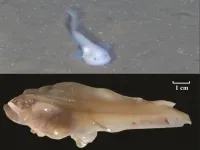(Press-News.org) Researchers at Hospital for Special Surgery (HSS) have identified risk factors for persistent opioid use after surgery in pediatric patients.1 Study findings were presented at the 2021 Spring American Society of Regional Anesthesia and Pain Medicine (ASRA) Annual Meeting.
Previous research indicates that prescription patterns for opioids after surgery in children and adolescents may be associated with long-term use and abuse.2
"Pediatric patients have developing brains that are uniquely vulnerable to addiction, and we need to learn to treat their pain safely without putting them at additional risk for opioid misuse," said principal investigator Kathryn (Kate) DelPizzo, MD, an anesthesiologist at HSS.
It is therefore critical for clinicians to understand risk factors for opioid dependence in this vulnerable population, and to develop strategies to prevent long-term opioid use.
Dr. DelPizzo and colleagues examined insurance claims from Truven Health Marketscan data from patients under the age of 21 who underwent inpatient or outpatient surgery from 2013 to 2017. The primary outcome examined was persistent opioid use after surgery, defined as one or more additional filled opioid prescriptions between 90 and 180 days post-surgery.
Out of more than 3.7 million patients, about 9% (N=345,523) filled at least one opioid prescription within six months after surgery, and 0.3% (N=11,334) developed ongoing opioid use.
Several risk factors were identified for persistent opioid use: older age, female sex, earlier year of undergoing surgery (e.g., 2013 versus 2014 through 2017), higher burden of comorbidities, previous use of antidepressants, residence outside of the Northeastern United States, having undergone an inpatient or a musculoskeletal procedure (versus general surgery or other specialties), and previous opioid use.
"This data gives an indication that providers may be able to use a patient's baseline characteristics to predict which children and adolescents are most at risk for trouble with opioids during the postsurgical period," Dr. DelPizzo noted.
HSS is committed to patient safety and being a leader in effective pain management. Its Controlled Substances Task Force continues to make strides in patient education and safe prescribing.
In addition to this study, HSS is ramping up further research on opioids with the help of a $3 million grant from the Starr Foundation. "Future research should explore what practical methods can be put into place to identify these at-risk pediatric patients and how to streamline protocols to help prevent long-term opioid dependence in these patients," Dr. DelPizzo concluded.
INFORMATION:
References
1. Kathryn DelPizzo MD, Haoyan Zhong MPA, Lauren A. Wilson MPH, Hannah N. Ladenhauf MD, Jiabin Liu MD PhD, Jashvant Poeran MD PhD, Stavros G. Memtsoudis MD PhD MBA FCCP. "Factors Associated With Long-term Opioid Use in Pediatric Surgical Patients." Presented at: 46th Annual Regional Anesthesiology and Acute Pain Medicine Meeting of the American Society of Regional Anesthesia and Pain Medicine (ASRA), May 13-15, 2021; Orlando, FL.
2. Harbaugh CM, Lee JS, Hu HM, et al. Persistent opioid use among pediatric patients after surgery. Pediatrics 2018; 141:e185838.
About HSS
HSS is the world's leading academic medical center focused on musculoskeletal health. At its core is Hospital for Special Surgery, nationally ranked No. 1 in orthopedics (for the 11th consecutive year), No. 4 in rheumatology by U.S. News & World Report (2020-2021), and named a leader in pediatric orthopedics by U.S. News & World Report "Best Children's Hospitals" list (2020-2021). HSS is ranked world #1 in orthopedics by Newsweek (2020-2021). Founded in 1863, the Hospital has the lowest complication and readmission rates in the nation for orthopedics, and among the lowest infection rates. HSS was the first in New York State to receive Magnet Recognition for Excellence in Nursing Service from the American Nurses Credentialing Center five consecutive times. The global standard total knee replacement was developed at HSS in 1969. An affiliate of Weill Cornell Medical College, HSS has a main campus in New York City and facilities in New Jersey, Connecticut and in the Long Island and Westchester County regions of New York State, as well as in Florida. In addition to patient care, HSS leads the field in research, innovation and education. The HSS Research Institute comprises 20 laboratories and 300 staff members focused on leading the advancement of musculoskeletal health through prevention of degeneration, tissue repair and tissue regeneration. The HSS Global Innovation Institute was formed in 2016 to realize the potential of new drugs, therapeutics and devices. The HSS Education Institute is a trusted leader in advancing musculoskeletal knowledge and research for physicians, nurses, allied health professionals, academic trainees, and consumers in more than 130 countries. The institution is collaborating with medical centers and other organizations to advance the quality and value of musculoskeletal care and to make world-class HSS care more widely accessible nationally and internationally. http://www.hss.edu.
In a study carried out in mice at the University of Chicago, researchers found that lasofoxifene outperformed fulvestrant, the current gold-standard drug, in reducing or preventing primary tumor growth. It also was more effective at preventing metastasis in the lung, liver, bone and brain, the four most common areas for this cancer to spread.
Additionally, while fulvestrant and similar drugs often cause unwanted, menopausal-like side effects, lasofoxifene prevents some of these symptoms. The research was published on May 13 in END ...
How people consume news and take actions based on what they read, hear or see, is different than how human brains process other types of information on a daily basis, according to researchers at the University of Missouri School of Journalism. While the current state of the newspaper industry is in flux, these journalism experts discovered people still love reading newspapers, and they believe a newspaper's physical layout and structure could help curators of digital news platforms enhance their users' experiences.
"Many people still love print newspapers, and to an extent, we also see that they like the digital replicas of print newspapers as much as they do the physical version," said Damon Kiesow, a professor of journalism professions and co-author on the study. "But we believe there ...
In a paper published in the May 13th, 2021 issue of PLOS Genetics, a Z-RNA nanoswitch that regulates interferon immune responses is described. The switch, less than 5 nanometer in length, is based on sequences, called flipons, that change outcomes by altering their three dimensional conformation. The Z-RNA nanoswitch flips from the shorter right-handed A-RNA helix ("on") to the longer left-handed Z-RNA helix ("off"). The flip ends immune responses against self RNAs, but not against viruses. Surprisingly, the Z-RNA nanoswitch sequence is encoded by "junk DNA". The Z-RNA nanoswitch is used by some cancers to silence anti-tumor immune responses. In other cases, a malfunction of the Z-RNA nanoswitch causes inflammatory disease.
In the ...
A new strategy for capturing the 3D shape of the human face draws on data from sibling pairs and leads to identification of novel links between facial shape traits and specific locations within the human genome. Hanne Hoskens of the Department of Human Genetics at Katholieke Universiteit in Leuven, Belgium, and colleagues present these findings in the open-access journal PLOS Genetics.
The ability to capture the 3D shape of the human face--and how it varies between individuals with different genetics--can inform a variety of applications, including understanding human evolution, planning for surgery, and forensic sciences. ...
Mutations in two genetic regions in dogs explain over one third of the risk of developing an aggressive form of hematological cancer, according to a study led by Jacquelyn Evans and Elaine Ostrander at the National Human Genome Research Institute in Maryland, USA and colleagues. The study, which combined multiple sequencing techniques to investigate histiocytic sarcoma in retriever dogs, publishes May 13 in the open-access journal PLOS Genetics.
Histiocytic sarcoma is an aggressive cancer of immune cells, and although extremely rare in humans, it affects around one-in-five flat-coated retrievers. Genome-wide association surveys of 177 affected and 132 unaffected flat-coated ...
A new whole genome sequence for the Yap hadal snailfish provides insights into how the unusual fish survives in some of the deepest parts of the ocean. Xinhua Chen of the Fujian Agriculture and Forestry University and Qiong Shi of the BGI Academy of Marine Sciences published their analysis of the new genome May 13th in the journal PLOS Genetics.
Animals living in deep-sea environments face many challenges, including high pressures, low temperatures, little food and almost no light. Fish are the only animals with a backbone that live in the hadal zone--defined as depths below 6,000 meters--and hadal snailfishes live in at least five separate marine trenches. Chen, Shi and their colleagues constructed a high-quality whole genome sequence from the Yap ...
Artificial intelligence (AI) learning machines can be trained to solve problems and puzzles on their own instead of using rules that we made for them. But often, researchers do not know what rules the machines make for themselves. Cold Spring Harbor Laboratory (CSHL) Assistant Professor Peter Koo developed a new method that quizzes a machine-learning program to figure out what rules it learned on its own and if they are the right ones.
Computer scientists "train" an AI machine to make predictions by presenting it with a set of data. The machine extracts a series of rules and operations--a model--based on information it encountered during its training. Koo says:
"If you learn general ...
QUT air-quality expert Distinguished Professor Lidia Morawska is leading an international call for a "paradigm shift" in combating airborne pathogens such as COVID-19, demanding universal recognition that infections can be prevented by improving indoor ventilation systems.
Professor Morawska led a group of almost 40 researchers from 14 countries in a call published in Science for a shift in standards in ventilation requirements equal in scale to the transformation in the 1800s when cities started organising clean water supplies and centralised sewage systems.
The international group of air quality researchers called on the World ...
For decades, governments worldwide have invested great deals of legislation and resources in food safety, sanitation and drinking water quality for public health purposes. However, the same cannot be said for the air quality of indoor public spaces, wherein the spread of airborne pathogens - whether those that cause the common cold or COVID-19 - is generally considered to be an "inescapable part of daily life." In a Policy Forum, Lidia Morawska and colleagues argue for a profound shift in how policymakers and building engineers view and approach indoor air quality and health, to reduce the spread of respiratory infection. According to Morawska et al., similarly to how food and waterborne disease ...
A subpopulation of neurons in the brain's zona incerta, or "zone of uncertainty," drives investigatory and novelty-seeking behavior in mice, according to a new study. The findings reveal a previously unknown brain circuit underlying innate curiosity; its discovery may one day have implications as a therapeutic target in animals or people who exhibit novelty-seeking behaviors, authors of a related Perspective say. Although curiosity - the motivational drive to investigate the unknown - is widely considered to be as intrinsic as hunger and thirst, and an ...


